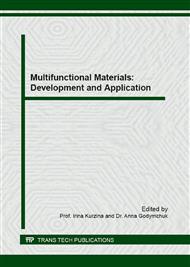[1]
W. Kingery, Factors Affecting Thermal Stress Resistance of Ceramic Materials, J. Am. Ceram. Soc. 38 (1) (1955) 3–15.
Google Scholar
[2]
D. Parkinson, Feeder and forehearth refractories, Gl. Tech. 29 (1988) 73–176.
Google Scholar
[3]
E. Thomas, Weichert T., Trends in usage in glass industry, Proc. UNITECR (1989) 730–760.
Google Scholar
[4]
D. Jarvis, An overview of the current 2013 global refractories industry, Intercam 62 (4) (2013) 262-266.
Google Scholar
[5]
Lee W., Moore R., Evolution of in situ refractories in the 20th century. J. Am. Ceram. Soc. 81 (6) (1998) 1385-1410.
Google Scholar
[6]
K. Dana, S. Sinhamahapatra, H. Tripathi, A. Ghosh, Refractories of Alumina-Silica System, T. Ind. Ceram. Soc. 73 (1) (2014) 1-13.
Google Scholar
[7]
O. Bories, I. Cabodi, Gaubil M., B. Malphettes, New Fused Cast Refractory for Metal Line Protection, Ceram. Eng. and Sc. Proc. 35 (1) (2014) 197-202.
DOI: 10.1002/9781118932964.ch19
Google Scholar
[8]
D. Larson, J. Coppola, D. Hasselman, Fracture toughness and spalling behavior of high-Al2O3 refractories, J. Am. Ceram. Soc. 57 (10) (1974) 417-421.
DOI: 10.1111/j.1151-2916.1974.tb11372.x
Google Scholar
[9]
B. Ghosh, R. Sinha, A. Chattopadhyay, Aluminosilicate Refractories for Special Applications in Non-Ferrous Metallurgy: Processing and Microstructure, Proc. UNITECR (2005) 652-657.
Google Scholar
[10]
A. Buhr, Trends in High Alumina Refractory Developments for Innovative Solutions, Proc. IREFCON (2014) 83-87.
Google Scholar
[11]
A. Guzman, D. Martinez, R. Gonzalez, Corrosion-erosion wear of refractory bricks in glass furnaces, Eng. Fail. Anal. 46 (2014) 188-195.
DOI: 10.1016/j.engfailanal.2014.09.003
Google Scholar
[12]
T. Mori, Y. Yamada, H. Yamamura, H. Kobayashi, T. Mitamura, Synthesis and Mechanical Properties of Alumina-MgO Stabilized Zirconia-Zircon Composite, J. Ceram. Soc. Jpn. 100 (3) (1992) 250–258.
DOI: 10.2109/jcersj.101.309
Google Scholar
[13]
L. Manfredo, R. McNally, The corrosion resistance of high ZrO2 fusion-cast Al2O3-ZrO2-SiO2 glass refractories in soda lime glass. J. Mater. Sci. 19 (4) (1984) 1272-1276.
DOI: 10.1007/bf01120038
Google Scholar
[14]
D. Yang, M. Ma, R. Liu, Y. Chu, Y. Yin, L. Li, G. Wan, Riser design of cast system of fused Zirconia-Alumina-Silica, Key Eng. Mat. 633 (2014) 498-502.
DOI: 10.4028/www.scientific.net/kem.633.498
Google Scholar
[15]
K. Beimdiek, H. Klischat, Dry and wet gunning - technico-economic refractory concrete concepts for highly loaded cement plants, Proc. UNITECR (2014) 167-172.
DOI: 10.1002/9781118837009.ch29
Google Scholar
[16]
S. Banerjee, H. Harbin, E. Reno, Spray-gunning refractories, Proc. UNITECR (1997) 553-562.
Google Scholar
[17]
Y. Mizuma, H. Tomono, H. Ohata, H. Ebisawa, T. Matsui, H. Otsubo, H. Takeuchi, M. Satou, Development of new dry gunning method, Proc. UNITECR (2011) 57-60.
Google Scholar
[18]
B. Myhre, B. Sandberg, The use of microsilica in refractory castables, Proc. of Int. Conf. on Mon. Refr. Mater. (1997) 113–140.
Google Scholar
[19]
A. Ruhov, T. Malinovskaya, V. Sachkov, M. Mishchenko, Photoinducedbactericidal activity of titanium dioxide nanoparticles attached to the surface of polypropylene fibers. Adv. Mater. Res. 880 (2015) 229-232.
DOI: 10.4028/www.scientific.net/amr.880.229
Google Scholar
[20]
O. Karban, O. Khasanov, Investigation of zirconia nanoceramics microstructure, Phys. of Low-dim. Struct. 3 (2003) 297-308.
Google Scholar
[21]
O. Nazarenko, Electroexplosive nanopowders: production, properties, application, TSU Ed., Tomsk, (2005).
Google Scholar
[22]
S. Bardakhanov, S. Kravets, V. Lysenko, V. Naumenkov, A. Nomoev, V. Obanin, D. Trufanov, A. Shibaev, Experimental determination of the dependence of starch looseness on the concentration of the silicon dioxide nanopowder (Tarcosil) in it, Russ. J. Non-Fer. Met. 50 (4) (2009).
DOI: 10.3103/s1067821209040142
Google Scholar
[23]
T. Malinovskaya, V. Vlasov, G. Volokitin, S. Melentyev, Investigation of Thermostability of a Composite Resistive Material with Nanodimensional Carbon Fillers, Rus. Phys. J. 57 (2) (2015) 245-251.
DOI: 10.1007/s11182-014-0231-9
Google Scholar
[24]
P. Kosmachev, Design technology and composition of nano-baddeleyite refractories for glass manufacturing [Razrabotka sostavov i tekhnologii polucheniya nanobaddeleitovykh ogneuporov dlya steklovarennoi promyshlennosti – in Russian], Vestn. TSUAB 6 (2014).
Google Scholar


